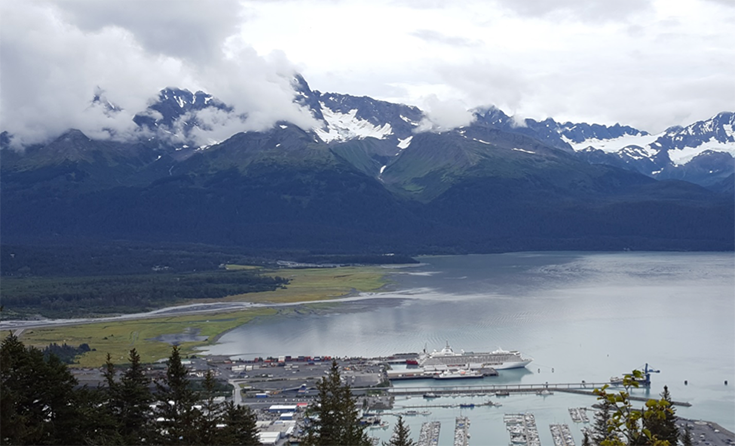Cruising the Northwest Passage: A Symbol of a Rapidly Changing Arctic
Published by Ocean Conservancy
SEWARD, ALASKA – Small only in comparison to the rocky peaks surrounding the city, the cruise ship Crystal Serenity easily dwarfed every other structure in Seward, Alaska. On August 16, she slipped her moorings and started a month-long voyage through the Northwest Passage with over 1,700 passengers and crew onboard.
This is an important milestone to us. The impact of climate change has now ushered in an era where a luxury cruise ship is able to sail from the North Pacific to the Atlantic via the fabled Northwest Passage—a route that once defeated even the most intrepid explorers. While other vessels have made the transit, this is the first time a tour ship of this size—almost the length of three football fields—has attempted the passage. Crystal Serenity’s journey is yet another symbol of a rapidly changing Arctic.
For those onboard, this could well be the trip of a lifetime. After all, the Arctic inspires awe and wonder around the world with its wild beauty, unparalleled wildlife and resilient peoples. Passengers will likely see a variety of wildlife including walruses, gray whales and millions of migratory birds that summer here. During their shore excursions, they will have the opportunity to interact with remote Arctic communities. Wherever they go, we hope they tread lightly.
This journey is not without risk. The Crystal Serenity has taken careful measures to prepare for its voyage but the Arctic is a harsh, punishing environment. Extreme distances and unpredictable weather conditions will pose a challenge if there in an emergency or accident. As more cruise ships attempt the Northwest Passage in the future, they may be less prepared. This will put a high degree of responsibility on small local communities and services. And it’s not just cruise ships. Other commercial vessels have started to make greater use of Arctic waters too.
While increased access means more opportunities, it also could put wildlife, local communities and an already fragile ecosystem at grave risk.
- Disruption to marine life: Some species of the Arctic marine ecosystem, particularly marine mammals, could be lethally impacted by vessel traffic-related ship strikes and noise—especially through the narrow Bering Strait, the only marine passage between the Pacific and Arctic oceans. Additionally, increase ocean noise can result in habitat displacement, behavioral changes and alterations in the intensity, frequency and intervals of whale calls.
- Threat of an oil spill: An oil spill could have devastating consequences in Arctic waters. What’s more, most large seagoing vessels use heavy fuel oil (HFO), also known as residual fuel or bunker fuel, due to its low cost. which is up to 50 times more toxic to fish than medium and light crude oil spills. It also produces significantly higher emissions of toxic sulfur, nitrogen oxides and particulate matter than other fuel alternatives. Fortunately, the Crystal Serenity is not using HFO—but future operators may not take this precaution.
- Extreme distances and unpredictable weather: In the event of an emergency or accident like an oil spill, the lack of effective response techniques and extremely limited response capacity will be very challenging. If a spill were to occur near Barrow, Alaska, the nearest major port of Dutch Harbor would be 1,300 miles away by boat. The nearest Coast Guard station at Kodiak is a 950-mile flight.
- Uncharted waters: Although the Arctic summer sea ice will be near its seasonal minimum during the next few weeks, the Northwest Passage is not entirely ice-free. Sea-ice forecasting is limited, and traveling in Arctic waters demands cautious and prudent navigation, which becomes even more challenging given that less than 2 percent (about 4,300 square nautical miles) of the U.S. Arctic waters has been surveyed with modern multibeam technology.
As part of a science-based conservation organization with a deep commitment to the Arctic, our team has been calling for measures that will improve ship safety and minimize threats to the Arctic wildlife:
- Improving navigational safety by using ship routing measures, such as recommended traffic lanes and Areas to be Avoided.
- Removing the use of heavy fuel oil in Arctic waters by working with partners to influence the International Maritime Organization, the body that governs international shipping.
- Supporting efforts to reduce ship strikes on marine mammals, improve vessel communications systems, enhance spill response preparedness, and reduce discharge from large, ocean-going vessels traveling in Arctic waters.
We will be following the journey of the Crystal Serenity closely until it docks in New York in September, wishing her a safe passage.
Read the full article at: http://blog.oceanconservancy.org/2016/08/17/cruising-the-northwest-passage-a-symbol-of-a-rapidly-changing-arctic/







